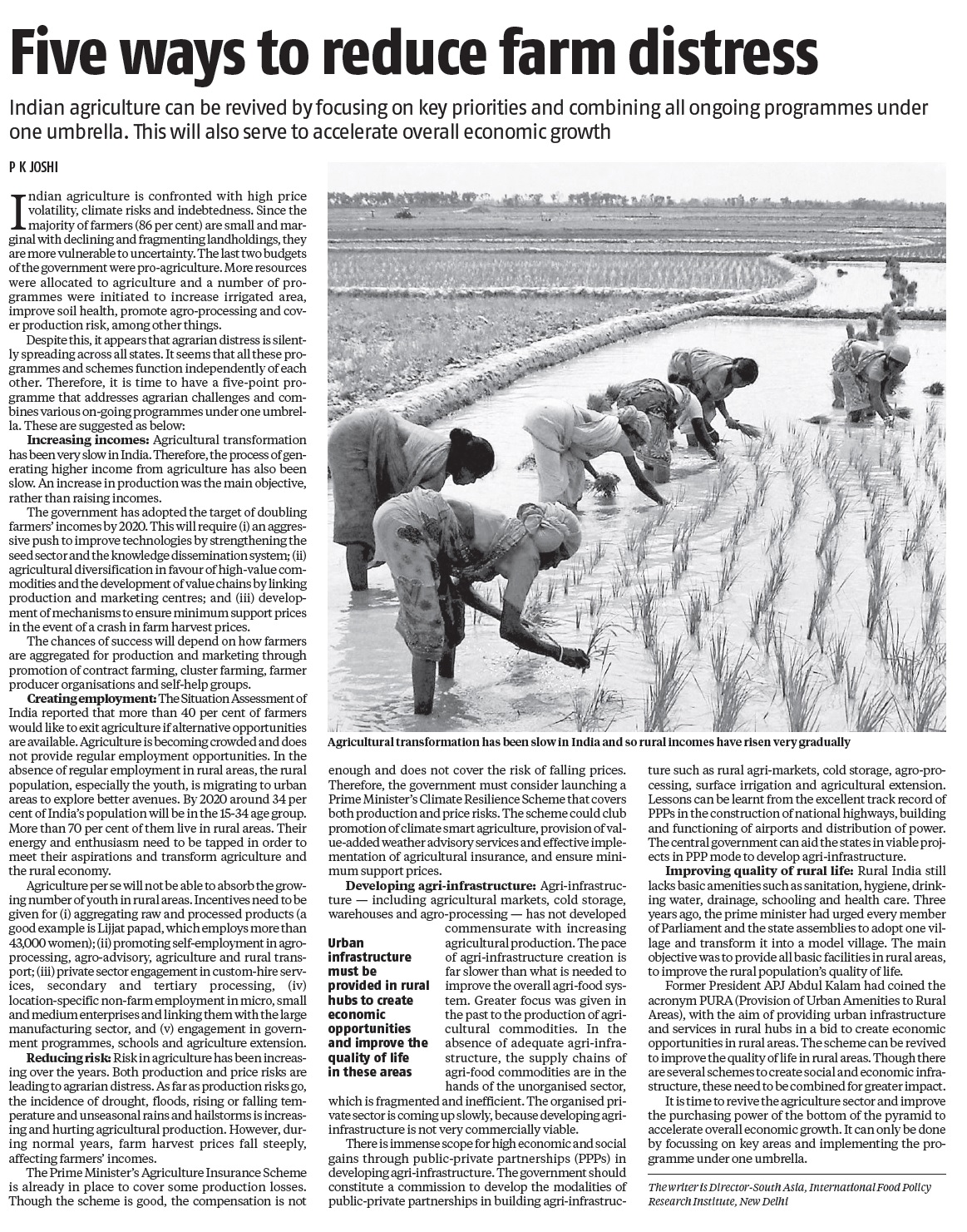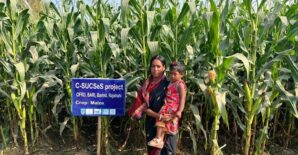 Indian agriculture is confronted with high price volatility, climate risks and indebtedness. Since majority of farmers (86%) are small and marginal with declining and fragmenting landholdings, they are more vulnerable
Indian agriculture is confronted with high price volatility, climate risks and indebtedness. Since majority of farmers (86%) are small and marginal with declining and fragmenting landholdings, they are more vulnerable
and risk prone to any of the uncertainty. The last two budgets of the government were pro-agriculture. More resources were allocated to agriculture and number of programs were initiated to increase irrigated area, improve soil health, promote agro-processing, cover production risk, among many others. Despite of this fact, it appears that agrarian distress is silently spreading across all the states. It seems that all these programs and schemes are disjointed and function independent of each other. Therefore, it is time to have a five-point program which addresses the agrarian challenges and converge various on-going programs under one umbrella. These are suggested as below:
Increasing incomes: Agricultural transformation is very slow in India. Therefore, the process of generating higher income from agriculture is also slow. Production increase was the main objective than raising incomes. It is welcoming that the Prime Minister has given target to double the income of farmers by 2020. This paradigm shift is expected to raise framers’ incomes. Within agriculture, it will require (i) aggressive push to improved technologies by strengthening seed sector and knowledge dissemination system; (ii) agricultural diversification in favour of high value commodities and develop value chains by linking production and marketing centres; and (iii) develop mechanisms to ensure minimum support prices in the event of crash in farm harvest prices. The condition for success will rely on how the farmers are aggregated for production and marketing through promotion of contract farming, cluster farming, farmer producer organizations and self-help groups.
Generating employment opportunities: The Situation Assessment of India reported that more than 40 percent of the farmers would like to quit agriculture if alternative opportunities are available. Agriculture is becoming crowded and does not provide regular employment opportunities. In the absence of regular employment in rural areas, the rural population, especially the youth, is migrating to urban areas to explore better avenues and income. There will be around 34 percent youth (15-34 age group) of total population in India by 2020. More than 70 percent of youth lives in rural areas. Their energy and enthusiasm need to be tapped for meeting their aspirations and transforming agriculture and rural economies. Agriculture per se would not be able to absorb the growing number of youth in rural areas. Incentives need to be given for (i) aggregating raw and processed products (good example is of Lizzat papad that employs more than 43 thousand women). (ii) self-employment in agro-processing, agro-advisory, agriculture and rural transport, etc., (iii) private sector engagement in custom-hire services, secondary and tertiary processing, (iv) location specific non-farm employment in micro, small and medium enterprises and link them with large manufacturing sector, and (v) engagement in government programs, schools, agriculture extension, etc.
Reducing risks in agriculture: Risk in agriculture is increasing over the years. Both production and price risks are leading to agrarian distress. On production risks, the incidences of droughts, floods, rising or falling temperature and unseasonal rains and hailstorms are increasing and adversely affecting agricultural production. However, during the normal years, farm harvest prices are steeply falling and badly affecting farmers’ incomes. Already Prime Minister’s Agriculture Insurance Scheme is in place to cover some production losses. Though the scheme is good but compensation is not enough and does not cover the risk of falling prices. Therefore, the government may consider launching ‘Prime Minister’s Climate Resilient Scheme’ that covers both production and price risks. The scheme may bundle promotion of climate smart agriculture, provide value added weather advisory services, effective implementation of agricultural insurance and ensure minimum support prices.
Developing agri-infrastructure: Agri-infrastructure, including agricultural markets, cold storage, warehouses, and agro-processing, have not developed in corresponding speed of increasing agricultural production. The pace of agri-infrastructure is far behind than it is needed to improve overall agri-food system. More focus in the past was given to production of agricultural commodities. In the absence of adequate agri-infrastructure, the supply chains of agri-food commodities are in the hands of unorganized sector which is fragmented and inefficient. Organized private sector is slowly coming up due to less commercial viability to develop agri-infrastructure. Role of public-private partnership (PPP) is immense in developing agri-infrastructure for high economic and social gains. Government may constitute a commission to develop modalities and proposals for public-private partnership in agri-infrastructure sector. Lessons may be learnt from excellent track record of PPP in constructing of national highways, building and functioning of airports, distribution of power, etc for developing agri-infrastructure (such as rural agri-markets, cold storage, agro-processing, surface irrigation and agricultural extension). Central government may contribute to states for viable projects in PPP mode to develop agri-infrastructure.
Improving quality of rural life: Rural India is still missing basic amenities (like sanitation, hygiene, drinking water, drainage, schooling and health centres). Three years ago, the Prime Minister encouraged each member of parliament and state assemblies to adopt one village to transform it into a model village. The main objective was to provide all basic facilities in rural areas to improve the quality of life. Former President late Dr APJ Abdul Kalam also gave a concept, namely “Provision of Urban Amenities to Rural Areas” (PURA), with the aim of providing urban infrastructure and services in rural hubs to create economic opportunities in rural areas. The scheme may be revived to improve the quality of life in rural areas. Though there are several programs and schemes to create social and economic infrastructure, these need to be converged for larger impact.
It is high time to revive agriculture sector and improve the purchasing power of the bottom of the pyramid to accelerate overall economic growth. It can only be done by focussing on key areas and implementing under one umbrella.
P K Joshi is director South Asia, International Food Policy Research Institute. This piece was originally published in The Business Standard



